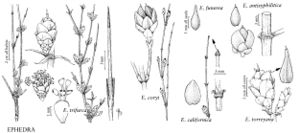Ephedra
Sp. Pl. 2: 1040. 1753; Gen. Pl. ed. 5, 462, 1754.
| Taxon | Illustrator ⠉ | |
|---|---|---|
 | Ephedra trifurca Ephedra californica Ephedra coryi Ephedra torreyana Ephedra funerea Ephedra antisyphilitica | John Myers John Myers John Myers John Myers John Myers John Myers |
Shrubs or occasionally clambering vines. Branches jointed, yellowish green to olive-green when young. Leaves opposite or in whorls of 3, apex obtuse to setaceous from an adaxial-median thickening. Pollen cones lanceoloid or ellipsoid to ovoid or obovoid. Seed-cones ellipsoid to ovoid, obovoid, or nearly globose. Seeds ellipsoid to globose, yellow to dark-brown, smooth to scabrous or furrowed. x = 7.
Distribution
Generally dry areas in temperate, tropical North America and Mediterranean regions, Mexico, South America (Ecuador to Patagonia and lowland Argentina), s Europe, Asia, n Africa (including Canary Islands)
Discussion
The species of Ephedra are presented here in alphabetical order for three reasons. First, no modern monographic treatment has been written for all species of the genus since that of O. Stapf (1889). Second, it appears that the species occurring in North America belong to at least three wholly different groups within the genus, but this is not yet supported by thorough systematic studies. Third, interspecific relationships within any putative infrageneric group occurring in North America are at best vague and ill defined.
The North American species of Ephedra are well defined based on combinations of vegetative and reproductive characters. Putative hybrids reported and described by H. C. Cutler (1939) appear to be products of singular events; these hybrids are discussed under the parental species. Infraspecific taxa are not recognized in this treatment because there appear to be no consistent defining characters and no geographic correlations; previous recognition of infraspecific taxa (H. C. Cutler 1939) appears to be based on random variability.
Species ca. 60 (12 in the flora).
Selected References
Lower Taxa
Key
| 1 | Leaves and bracts mostly in whorls of 3. | > 2 |
| 1 | Leaves and bracts mostly opposite. | > 5 |
| 2 | Cones always sessile; seeds scabrous. | Ephedra torreyana |
| 2 | Cones usually with short, scaly peduncles (rarely sessile); seeds usually smooth (sometimes scabrous in E. funerea). | > 3 |
| 3 | Terminal buds spinelike; leaf bases shredding with age; cone bracts reddish brown. | Ephedra trifurca |
| 3 | Terminal buds acute at apex; leaf bases persistent or completely deciduous; cone bracts yellow, green-yellow, or orange-yellow. | > 4 |
| 4 | Leaf bases deciduous; twigs yellow-green; cone bracts as broad as long; seeds nearly globose. | Ephedra californica |
| 4 | Leaf bases persistent, forming a black, thickened collar; twigs gray-green; cone bracts longer than broad; seeds ellipsoid. | Ephedra funerea |
| 5 | Branches lax, vinelike, trailing or clambering; microsporangial stalks 1-2 mm. | Ephedra pedunculata |
| 5 | Branches rigid; microsporangial stalks less than 1 mm. | > 6 |
| 6 | Twigs viscid. | Ephedra cutleri |
| 6 | Twigs not viscid. | > 7 |
| 7 | Leaf bases persistent, forming a black, thickened collar; nodes obviously swollen; seeds 2. | > 8 |
| 7 | Leaf bases completely deciduous or becoming gray and shredded with age; nodes not or only inconspicuously swollen; seeds 1-2. | > 9 |
| 8 | Twigs with smooth ridges; seed cones sessile or on short, scaly peduncles, inner bracts membranous, with yellow center and base. | Ephedra viridis |
| 8 | Twigs with slightly scabrous ridges; seed cones usually on long, smooth peduncles, inner bracts fleshy (at least in center) and orange. | Ephedra coryi |
| 9 | Leaf bases completely deciduous, brown when shed; seeds 1-2. | > 10 |
| 9 | Leaf bases persistent and shredding, brown, becoming gray with age; seed 1. | > 11 |
| 10 | Bracts of pollen cones yellow to light brown; inner bracts of seed cones herbaceous; seeds (1-)2. | Ephedra nevadensis |
| 10 | Bracts of pollen cones pale green to red; inner bracts of seed cones fleshy and red; seeds 1(-2). | Ephedra antisyphilitica |
| 11 | Twigs usually scabrous; bracts of pollen cones yellow to red-brown; seeds smooth to slightly scabrous. | Ephedra aspera |
| 11 | Twigs smooth or very slightly scabrous; bracts of pollen cones light yellow; seeds furrowed. | Ephedra fasciculata |